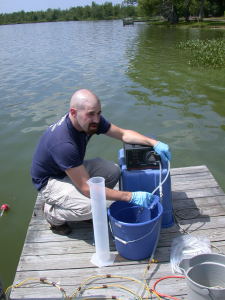There are thousands of different types of blue-green algae, and only a few produce harmful toxins. Tell your friends to listen to this:

A researcher runs tests on the green waters of an algal bloom. (via Greg Boyer)
Blue green algae aren’t all bad. After all, there are about 6,000 different species…
Boyer: And there are probably only a hundred or so that are known to make toxins that would be considered harmful.
That’s Greg Boyer of the SUNY College of Environmental Science and Forestry. He says the organisms are some of the oldest and most diverse on the planet. They thrive in sun, warmth, and calm waters. But add to that too many nutrients, and they can bloom out of control.
Some blooms make toxins that can be harmful if ingested, touched, or even inhaled. But others do not…the trouble is you can’t tell which is which without a toxicity test. So, play it safe… if you see an algal bloom – stay away.
Hear More:
Listen to Greg Boyer describe what to do if you or a pet come into contact with an algal bloom.
Get Schooled:
- Check your understanding of algal blooms with this page from Michigan Sea Grant.
The Fine Print:
- This segment was produced with Cornell’s Atkinson Center for a Sustainable Future, and supported by agreement with New York Sea Grant, funds provided by the Environmental Protection Fund under the authority of the New York Ocean and Great Lakes Ecosystem Conservation Act. Any opinions, findings, conclusions or recommendations expressed in this broadcast are those of the originators and do not necessarily reflect the views of Stony Brook University or New York Sea Grant.




